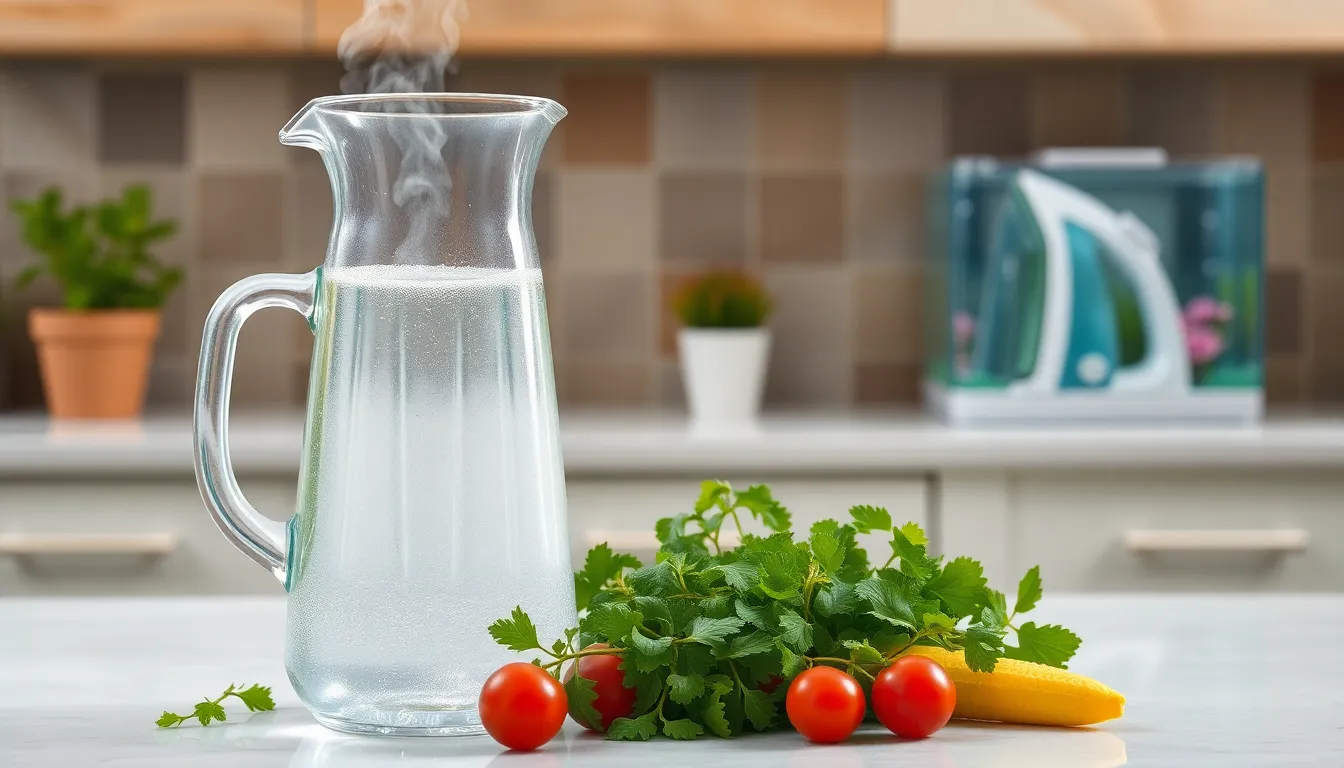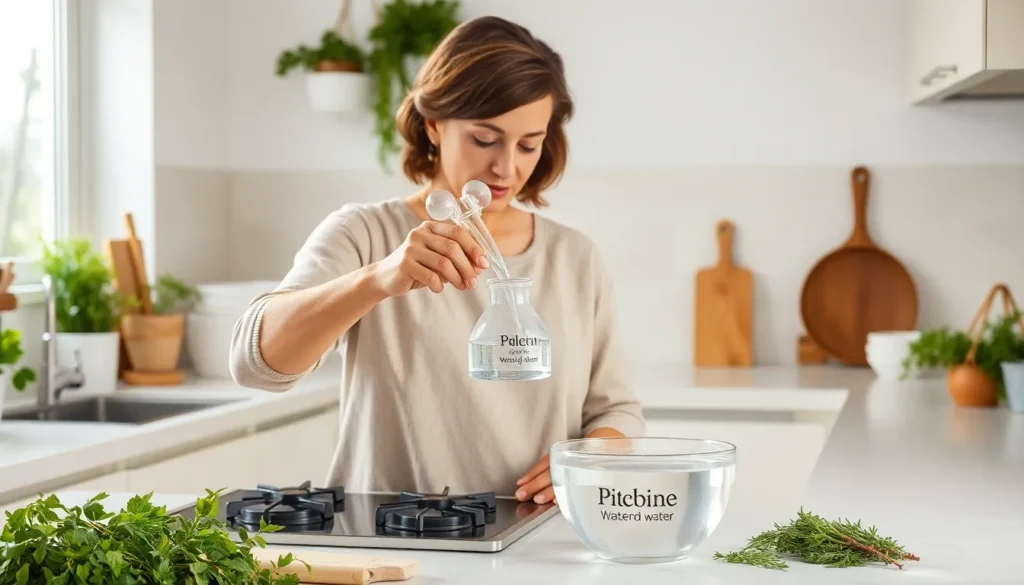Table of Contents
ToggleIn a world where hydration is key, why settle for tap water when you can make your own distilled water at home? It’s like turning your kitchen into a mini science lab, minus the safety goggles and lab coat. Distilled water isn’t just for fancy steam irons or that high-tech coffee maker; it’s a versatile solution that can elevate everything from your drinking experience to your gardening game.
Why Make Distilled Water At Home
Making distilled water at home offers multiple advantages that enhance daily living. It provides a pure alternative to tap water, which often contains impurities and contaminants. Distillation effectively removes these elements, ensuring the water is safe for drinking and cooking.
The versatility of distilled water extends to various applications. Plants benefit from distilled water as it lacks minerals that can build up in the soil, promoting healthier growth. Appliances like steam irons and humidifiers operate more efficiently with distilled water, preventing mineral buildup and prolonging their lifespan.
Health-conscious individuals often prefer distilled water for its clean and neutral taste. Taste preferences vary, but many find that using distilled water in beverages, such as coffee and tea, improves flavor clarity. Monitor hydration levels through the use of high-quality water, enhancing overall wellness.
Cost savings factor into the decision to produce distilled water at home. Rather than purchasing expensive bottled water, individuals can create their own supply from the comfort of their kitchens. A simple distillation process requires minimal equipment, making it accessible for most households.
Environmental concerns also support making distilled water at home. Reducing reliance on single-use plastic bottles contributes to less waste in landfills and oceans. Since distilled water is reusable for various purposes, it supports sustainability efforts.
Convenience plays a role in the appeal of homemade distilled water. With basic tools and a straightforward process, individuals can easily generate as much water as they require. This self-sufficiency fosters a greater connection to personal consumption and health choices.
Benefits Of Distilled Water

Homemade distilled water offers numerous advantages that contribute to a healthier lifestyle and everyday efficiency.
Health Advantages
Purity defines distilled water. It lacks contaminants and impurities found in tap water, making it a safe option for hydration. Drinking distilled water can lead to better digestion and reduce the risk of waterborne illnesses. Its mineral-free composition benefits individuals with specific health conditions, as it doesn’t introduce unwanted substances into the body. Hydration improves when using it in recipes or beverages, enhancing flavors without altering health benefits. Choosing distilled water supports optimal nutrient absorption in the body, promoting overall wellness.
Household Uses
Versatility showcases distilled water’s place in the home. It serves a variety of household tasks effectively. Steam irons function better with distilled water since it eliminates mineral buildup, extending appliance life. Cleaning tasks benefit too, as it avoids residue that hard water creates. Aquariums thrive on distilled water, providing fish with a chemical-free environment. Distilled water also aids in the longevity of plants since it lacks chlorine and other additives harmful to growth. Utilizing distilled water in cooking enhances the flavors of soups and sauces, elevating meals effortlessly.
Methods To Make Distilled Water At Home
Creating distilled water at home can be accomplished effectively through several methods. These methods ensure purity while eliminating contaminants.
Using a Stovetop Setup
This stovetop method relies on boiling water to create steam. He or she should fill a large pot with water, ensuring no more than halfway full. In the center, place a heat-resistant bowl to catch the condensed steam. Cover the pot with a lid, positioned upside down to collect the steam. Once the water reaches a boil, steam rises, condenses on the lid, and drips into the bowl. After 30 minutes, cooling the setup permits safe handling. Homemade distilled water is ready for use, offering a practical solution for various applications.
Using an Electric Distiller
Using an electric distiller simplifies the distillation process. The device heats water to create steam, which then condenses in a separate compartment. Users need to fill the distiller’s chamber with tap water, then turn it on. As it operates, impurities are left behind, resulting in pure distilled water. The process typically takes 4 to 6 hours, depending on the distiller capacity. After completion, he or she can access clean, distilled water for drinking and other uses. This method requires minimal effort while ensuring high-quality water.
Common Mistakes To Avoid
Creating distilled water at home can be simple, but several common errors may affect the water’s quality. Not using clean containers can introduce impurities. Always remember to start with sanitized equipment to maintain purity.
Using non-distilled water in the process leads to contamination. The source water should be as clean as possible, ideally filtered or purified. Skipping the cooling phase can cause burns or accidents. Careful handling ensures safety when working with hot materials.
Overlooking the importance of steam flow affects the distillation efficiency. Positioning bowls and lids correctly prevents steam from escaping and allows for effective condensation. Underestimating the time required for distillation may result in incomplete processes. Stovetop setups typically require about 30 to 60 minutes, while electric distillers may take several hours.
Neglecting to monitor water levels can also cause issues. Adding water in intervals during distillation helps manage the process. Failing to clean equipment regularly leads to residual buildup over time. Routine cleaning after each use maintains the apparatus and enhances future results.
Lastly, ignoring specific guidelines for water temperature and boiling can diminish efficacy. Boiling water between 212°F and 220°F is optimal for generating steam. By avoiding these common mistakes, individuals can achieve high-quality distilled water consistently.
Making distilled water at home offers numerous benefits that can enhance daily life. From improving hydration to supporting plant growth it’s a simple yet effective way to ensure purity in water consumption. The process not only promotes health but also contributes to environmental sustainability by reducing plastic waste.
By mastering the techniques outlined in the article anyone can easily produce high-quality distilled water. This self-sufficiency empowers individuals to take control of their water sources while enjoying the advantages of cleaner and healthier options. Embracing homemade distilled water is a step toward better wellness and a more sustainable lifestyle.




